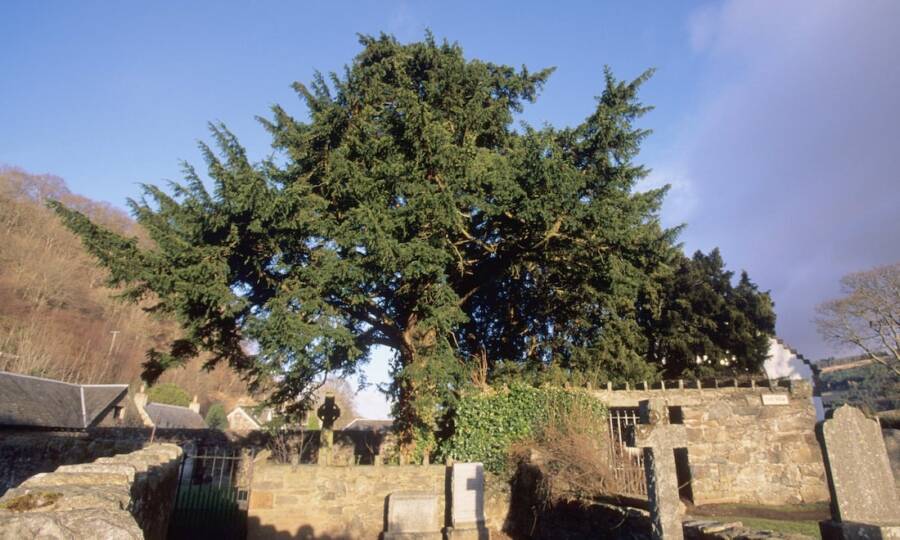The Fortingall Yew may have been growing when the Pyramids and Stonehenge were being built.

Mogens EngelundThe Fortingall Yew tree in Perthshire, U.K., could be the oldest living organism in Europe.
Crowds of unruly people can be stressful in any situation, but it has been particularly rough for the Fortingall Yew which is considered the oldest living tree in the U.K. and potentially in Europe.
Tourists who have come to visit the potentially 5,000-year-old tree have ripped off its branches and twigs and attempted to hang beads and ribbons off of it. According to the tree’s handlers, all this activity has caused the tree to physically suffer.
“They are attacking this poor tree, it’s stressed, and whether that’s the reason this poor tree is not doing very well at the moment, we don’t know,” Catherine Lloyd, coordinator of the Tayside Biodiversity Community Partnership, told The Scotsman.
The Fortingall Yew is located inside the Fortingall Churchyard in Perthshire where its trunk has grown into a massive body at least 52 feet wide 23 feet high. It is known to be the oldest tree in the U.K. and potentially in all of Europe, but yews are notoriously difficult to age. It has been enclosed in a high stone and iron wall for protection since the Victorian era, though that has done little to stop handsy tourists.
Over time, the yew has grown separate trunks that appear to have split up and congregated into a smaller group of trees. Today, it almost resembles a grove of yews all its own. This behavior in the tree, however, is considered normal — especially when compared with the condition it has undergone as of late.
Researchers can’t know for sure how old it is exactly since the insides of the bark have rotted and hollowed — another typical old yew trait — but based on ring counts and historical measurements taken in the 19th century, experts estimate the yew tree is at least 2,000 years old. At most, it is over 5,000 years old.
That means that the tree could already have been alive and growing as the Great Pyramid of Giza and Stonehenge were being built, as noted by the blog of the Royal Botanic Garden of Edinburgh.
But modern tourists are severely endangering the tree’s longevity. One person wanted to hang up souvenirs on the Fortingall tree so bad that they somehow managed to trample and destroy the metal plaque that was officially erected by the Tree Council.
This unchecked behavior has come at a price. As a result, the Fortingall Yew has shown signs of distress, one of which is the tree’s surprising sex change in 2015.
After living for millennia as male, the tree miraculously bore red berries on its outer crown which is a distinct behavior of female trees. While switching sexes is common among trees, the yew had only been growing berries on one branch. This indicated that the tree’s sex change was only a partial change — a rare occurrence among yews and could be a sign that the tree is under duress.

Edward Parker/AlamyThe Church Yew Tree Project aims to plant and grow saplings from the Fortingall Yew’s DNA in 20 other church yards by 2020.
“It’s a strategy for longevity,” Ancient Tree Forum Chair Brian Muelaner told The Guardian. “The Fortingall Yew is fragmented and it may be so compartmentalized that part of it has become sexually ambiguous. We are all continuously learning about ancient trees – the aging process of trees is a new science.”
Interestingly, these shenanigans from tourists aren’t even the worst that the Fortingall Yew has been through. Historical accounts speak of holiday bonfires at the base of the tree and horse-riding through its widened middle.
“People have been unkind to the tree for centuries,” Lloyd said. In some cases, chunks of bark were removed to make cups in the 19th century.
Now, in an effort to preserve the ancient tree’s DNA, Fortingall Yew’s caretakers have launched an initiative called the Church Yew Tree Project, which is meant to stretch over a period of 10 years to create and distribute yew tree hedges in other churchyards.
The Royal Botanic Garden in Edinburgh has planted their own yew hedge with cuttings from the ancient Fortingall Yew which will hopefully grow between 30 to 50 new tree saplings. The project aims to spread their mission onto 20 church yards by 2020. The Fortingall Yew’s deteriorating health emphasizes the importance of preserving its biological lineage now more than ever.
“If we’ve got its progeny, we’ve got its clones growing elsewhere, then the DNA will be looked after and safeguarded, and we will have more important yew trees,” Lloyd said.
Next, read about California’s Methuselah tree, which is the oldest tree in the world. And then, learn the story of Sweden’s Old Tjikko tree, another candidate for the title of world’s oldest tree.





